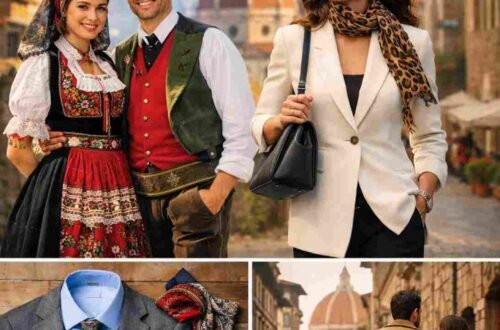Turkmen clothing is colorful, detailed, and full of history. Every piece shows the lifestyle and culture of the Turkmen people. These clothes come from a long tradition of nomadic life, where design and comfort were both important. In this guide, you will learn about the history, main clothing items, meanings, and how Turkmen people keep these traditions alive today.
Historical and Cultural Background
Turkmen clothes were made for people who lived and traveled across large deserts and open lands. The clothes had to protect them from heat, cold, and wind. Over time, tribes such as Tekke, Yomud, and Ersari developed their own styles and embroidery patterns. The Silk Road brought new materials like silk and silver, which made Turkmen clothing more decorative. Even today, traditional dress plays a big role in weddings, festivals, and national celebrations.
Main Clothing Items
Here are some of the main pieces of Turkmen clothing and what they mean:
| Name | Description | Worn by |
|---|---|---|
| Koynek | Long embroidered dress | Women |
| Balaq | Trousers under the dress | Women |
| Chyrpy | Cloak worn outdoors | Women |
| Don/Chapan | Long robe or coat | Men |
| Telpek | Large sheepskin hat | Men |
| Ketene | Silk fabric used for belts or robes | Men & Women |
| Yasmak/Jooluk | Veil or scarf | Women |
| Chyrka | Decorative sash or belt | Men & Women |
Each piece shows the person’s tribe, age, or social position.
Men’s Clothing
1. Basic Clothing
- A cotton or wool shirt and wide trousers.
- Made for easy movement while riding or working.
2. Outerwear
- Don or Chapan: A long coat tied with a ketene silk belt.
- Warm in winter, lighter versions for hot days.
3. Headwear
- Telpek: A large, fluffy sheepskin hat that keeps the head warm and shows pride.
- Kalpak: A lighter felt cap used for everyday life.
4. Shoes and Accessories
- Leather boots for travel and work.
- Simple silver belts or small decorative items for ceremonies.
Read also: Complete Guide to Serbian Clothing
Women’s Clothing
1. Main Outfit
- Koynek: A long dress with bright embroidery.
- Balaq: Trousers under the dress for comfort and modesty.
2. Outer Layers
- Chyrpy: A robe worn over the dress, especially outdoors.
- Yasmak or Jooluk: A scarf or veil.
- Red for brides
- Green for young women
- Dark colors for older women
3. Embroidery and Colors
- Embroidery is called Goçak.
- Common colors and meanings:
- Red: Strength and happiness
- Black: Protection
- Green: Life and nature
- Each tribe has its own special patterns.
4. Jewelry and Decoration
Turkmen jewelry is very detailed and made mostly from silver and carnelian stones. Common pieces include:
- Bracelets and necklaces
- Headdresses and chest ornaments
Silver is believed to protect from evil, and carnelian symbolizes courage and energy. Brides wear many jewelry pieces on their wedding day.
5. Shoes and Belts
- Leather or embroidered boots for travel.
- Silk sashes like the chyrka tie the outfit together.
Regional and Tribal Styles
| Tribe | Style Feature | Main Colors |
|---|---|---|
| Tekke | Fine silk embroidery | Red and gold |
| Yomud | Floral and dark designs | Brown and red |
| Ersari | Heavy fabric, lots of jewelry | Green and burgundy |
| Saryk | Geometric shapes | Red and orange |
| Chowdur | Mix of nearby styles | Beige and soft tones |
Each tribe’s clothing shows its history and environment.
Ceremonial and Modern Clothing
Weddings:
- The bride wears a long red dress with silver and carnelian jewelry and a veil.
- The groom wears a dark chapan and a tall telpek hat.
Both outfits symbolize good luck and happiness for the future.
Festivals and Modern Use:
- People still wear traditional clothes on national holidays and cultural shows.
- Modern designers use traditional embroidery and colors in new styles.
- These updates help keep Turkmen identity alive in the modern world.
Materials and Making Process
| Material | Used For | Meaning |
|---|---|---|
| Cotton | Everyday clothes | Simplicity |
| Silk (Ketene) | Fine robes and belts | Luxury |
| Wool | Warm coats and hats | Strength |
| Sheepskin | Telpek hats | Protection |
| Silver & Carnelian | Jewelry | Luck and courage |
Women often learn embroidery from their mothers and pass it down. Natural dyes made from plants and roots give the clothes their strong colors. Every pattern and symbol tells a story—such as diamonds for fertility or horns for strength.
Buying and Caring for Traditional Clothing
Where to Find:
- Local markets in Ashgabat, Mary, and Dashoguz
- Artisan shops and cultural centers
Tips for Buyers:
- Choose items with hand embroidery.
- Ask about the meaning of patterns.
- Support local craftswomen and cooperatives.
Care Instructions:
- Keep silk clothes away from direct sunlight.
- Air dry wool and felt coats.
- Polish silver jewelry gently without chemicals.
Conclusion
Turkmen clothing is not only beautiful but also meaningful. It tells the story of the people, their history, and their skills. Every hat, dress, and piece of jewelry shows a part of Turkmen life. Even in modern times, these clothes remind people of their roots and the strong link between art, culture, and tradition.





